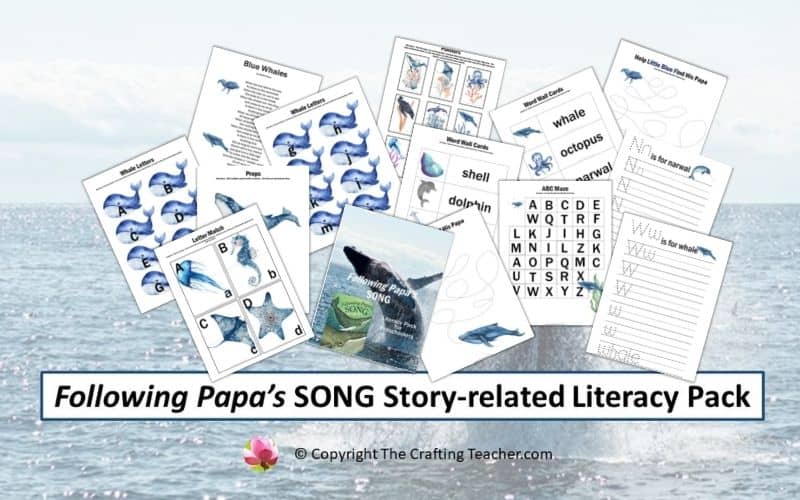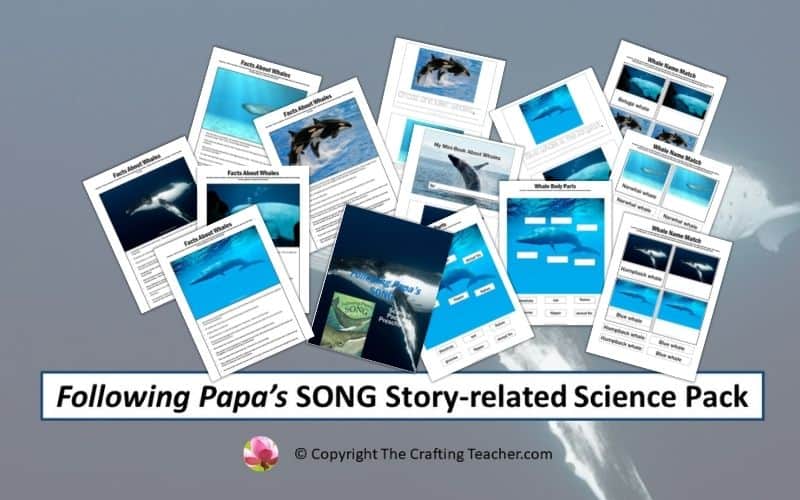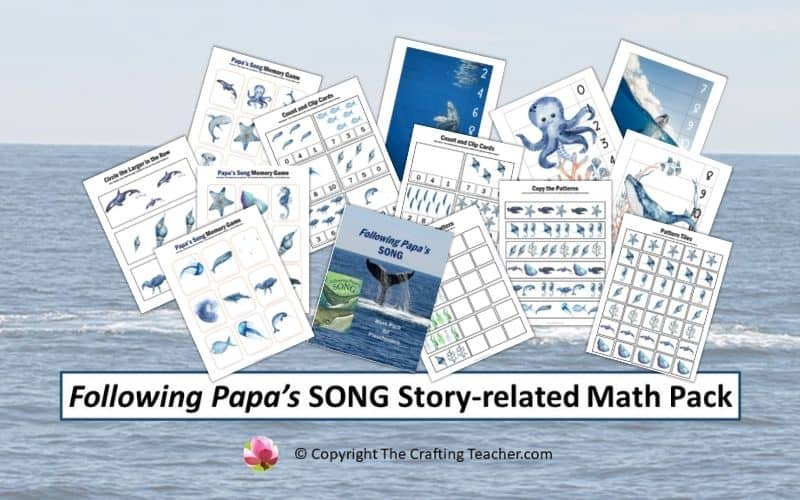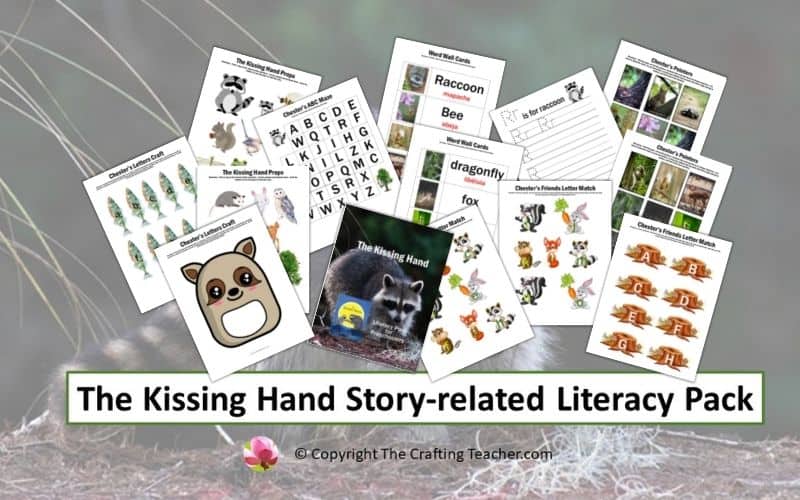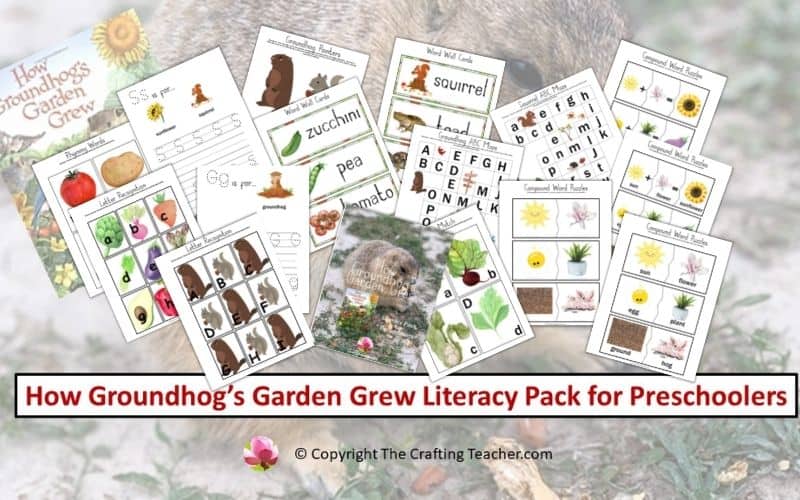Following Papa’s Story-related Literacy Pack for Preschoolers
Affiliate Disclosure: “This post contains affiliate links, which means I receive a small commission, at no extra cost to you, if you make a purchase using those links.”
One of my most difficult experiences as a teacher was the time that I had to teach Language Arts, Social Studies, and Science to Elementary and Middle School children using the Whole Language method, which is teaching everything you need without textbooks, only storybooks, research, and hands-on activities.
My love for books and that wonderful and very challenging experience taught me that storybooks are an incredible source of knowledge and activities, and you can teach literacy, math, social studies, science, and art if you pay attention to what a book has to offer.
On this occasion and with Father’s Day approaching soon, I wanted to bring you one of my favorite books, which I consider appropriate for the occasion.
Following Papa’s SONG by Gianna Marino is a book that talks about two whales, a papa whale, and a baby whale called Little Blue, that are swimming together through the big ocean, while Little Blue asks many questions Papa, especially ones about the long migration. How will they know the way? Will he be able to keep up? What will they see along the way?
Papa has answers for all these questions, but Little Blue remains curious as they begin their journey and decides to swim down below to see the magical world that is there until there is only darkness surrounding the young whale and he’s lost. But Little Blue remembers that if he is quiet and listens, he can hear Papa’s song and find the way back to Papa.
Filled with the wonders of the ocean and the comfort of a father’s presence, Following Papa’s SONG is a heartwarming story that talks about the incredible bond between a father and a son.
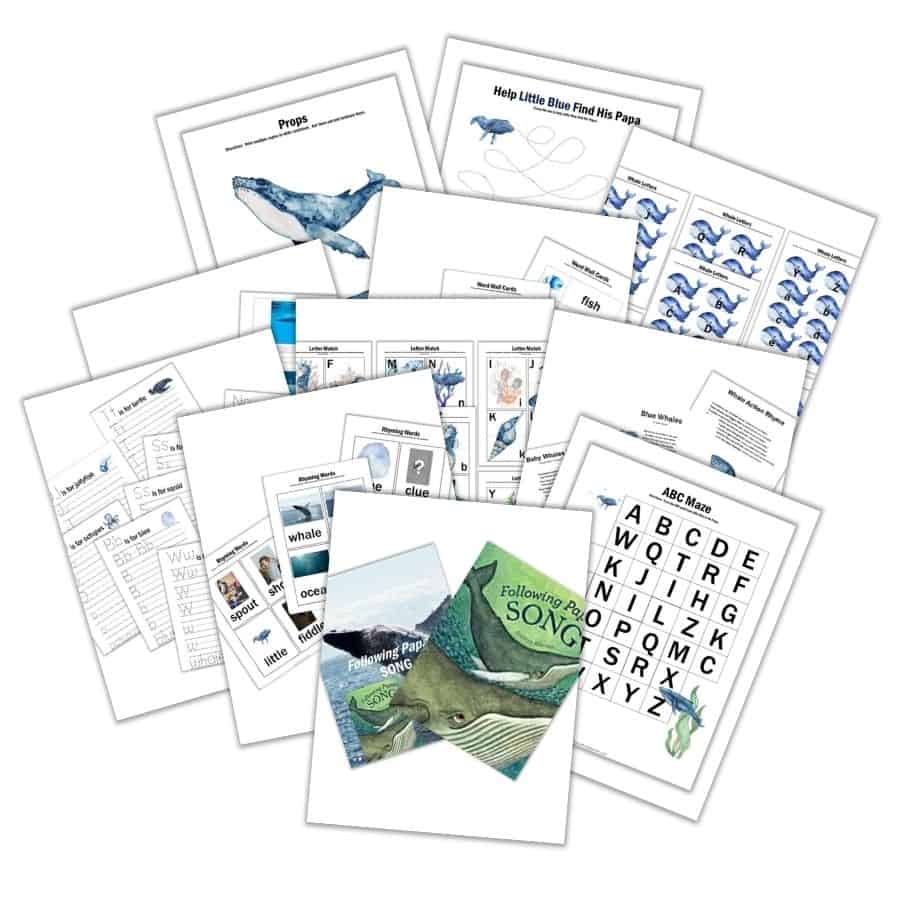
I have created a FREE 45-page literacy pack with 10 different types of activities to go along with this book, which you can download at the end of this post. In the meantime, I would like to tell you what I have included and give you some ideas of activities you can do, to take advantage of this wonderful book.
Start by showing them the pictures in the book without reading. Use the opportunity to ask questions and let them comment about what they see. Then read the story.
When I read a book, I like to use pointers to mark the words as I’m reading. That is an easy and very efficient way to show preschoolers that you read from left to right and top to bottom and that words have meaning.
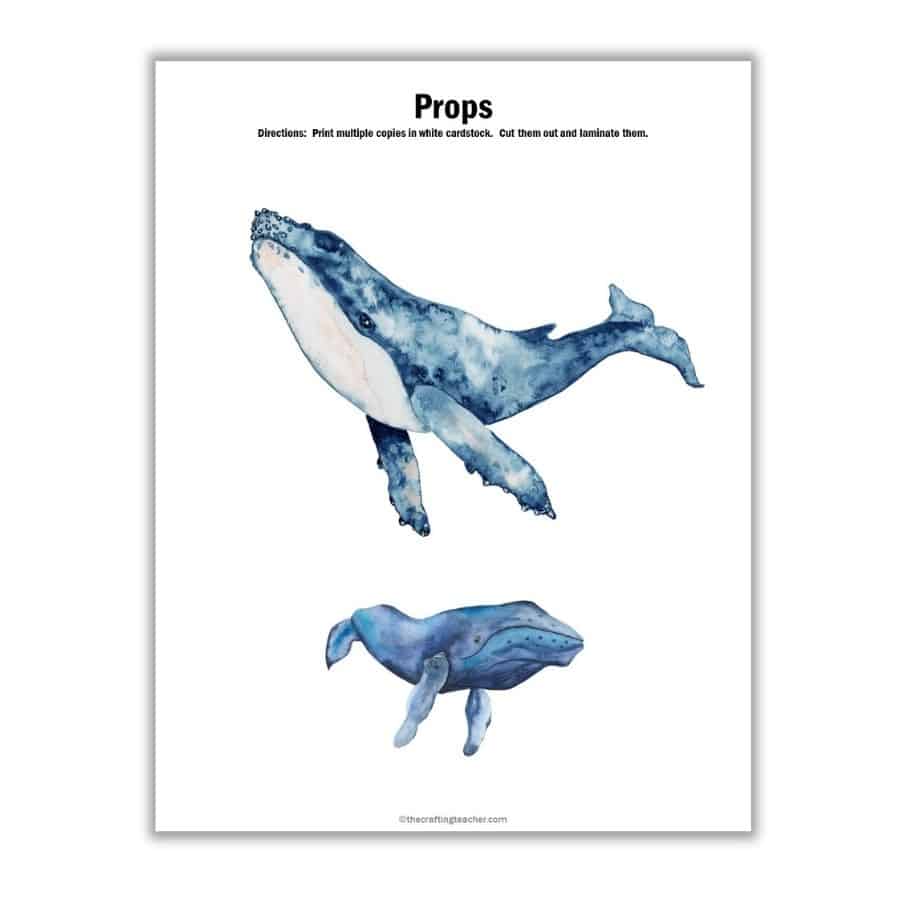
I included these FREE props in the bundle for you to use as pointers when you read this book. You just have to print them in white cardstock, cut them out, laminate them, and glue them to tongue depressors, for easier use.
Importance of Literacy
The development of literacy skills includes awareness of books and prints, knowing the relationships between letters and sounds that makeup words, vocabulary development, and understanding stories. It is a process that starts from the very beginning of a child’s life, and it is the base for his or her future language development and the ability to read, write, and overall learning. If a child cannot read, it will be impossible for him or her to learn important concepts such as Math and Science, and understand the world around him or her.
Reading Aloud and Emergent Comprehension
Questions About The Story
Before reading review the parts of the book: cover, title, author, illustrator, spine, and back.
Show them the cover and ask them what type of animals they think are those. Tell them they are blue whales, the largest mammal in the world. Review what is a mammal.
During reading ask who, what, where, when, and why questions, such as:
- Who are the main characters of the story?
- Where is the story taking place?
- When do you think the whales sing?
- Why do you think is so dark down at the bottom of the ocean?
Also, ask open-ended questions such as questions about the student’s life experiences. Open-ended questions are the ones that can have multiple answers.
After reading questions about the story, such as:
- Why do you think Little Blue went down below to the dark?
- What other animals did you see in the book?
- What do you think could’ve happened to Little Blue if he didn’t find his papa?
- Why do whales sing?
Retelling The Story
Gather the children in a circle on the floor. Place a blue sheet of paper in the middle of the circle, and tell them that it represents the ocean.
Print several copies of the props I provided in the FREE PDF using white cardstock. Cut them out and laminate them. Distribute the story props among the students and encourage them to retell the story using their props. They should place the props in the “ocean” to act out the story. When the activity is complete, place the props and the ocean in the Listening or Library Center, to invite the children to retell the story on their own.
Oral Language and Vocabulary Development
If you use a Word Wall, add the words provided in the printable, to teach them to your students. I use the names of the sea creatures that appear in the book for that. I also provided cards with facts about these animals, to make it easier for you.
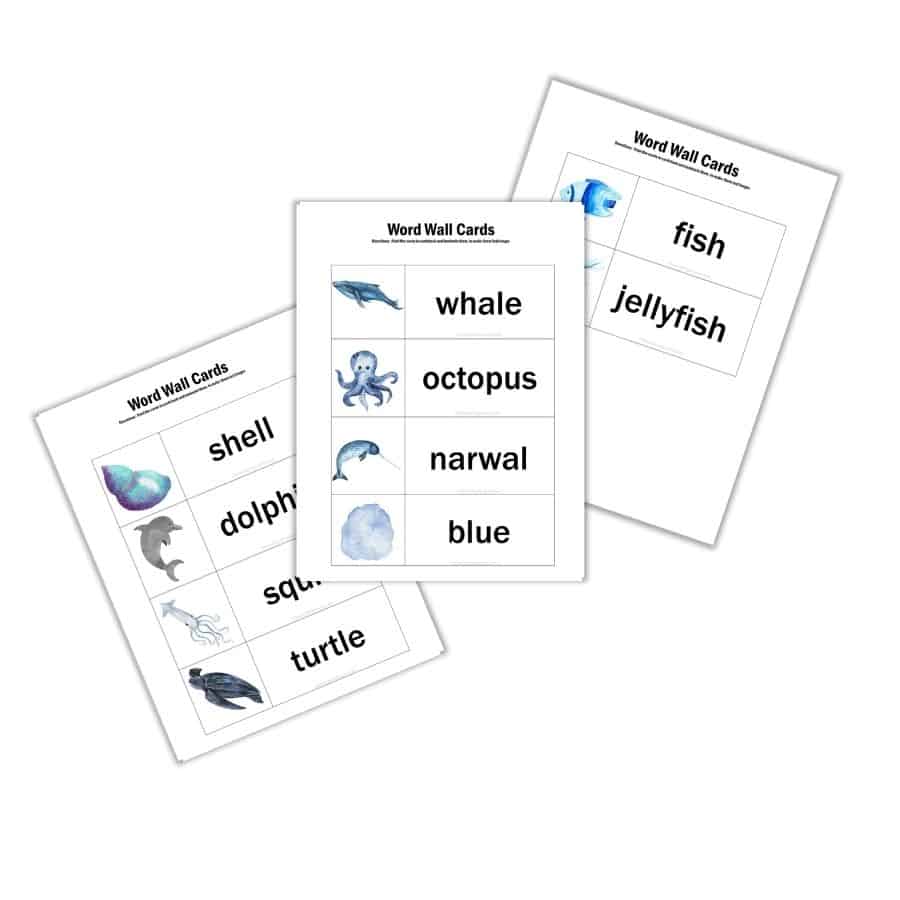
The FREE Following Papa’s SONG literacy pack includes twelve vocabulary cards, including whale, octopus, narwhal, blue, shell, dolphin, squid, turtle, fish, and jellyfish.
Tell your preschoolers that whales travel in pods, which are groups of whales of about 10 whales. Then teach them the song below. Insert a Wall card. Repeat the song for other word cards on the Word Wall.
Whale Song
(Sung to the tune of “The Farmer in the Dell”)
The whales are singing their song,
while traveling in pods,
Show me the word (whale),
Before they swim away.
Encourage your children to use each Word Wall word in a short sentence.
Letter and Sound Knowledge
Fill a clear container with water-tinted blue. Place a whale letter under it and invite a student to identify the letter that is “under the ocean”. The FREE Following Papa’s SONG literacy pack includes all the letters of the alphabet, in uppercase and lowercase versions. Preschoolers can also use them to match both versions, to spell words, to spell their names, etc.
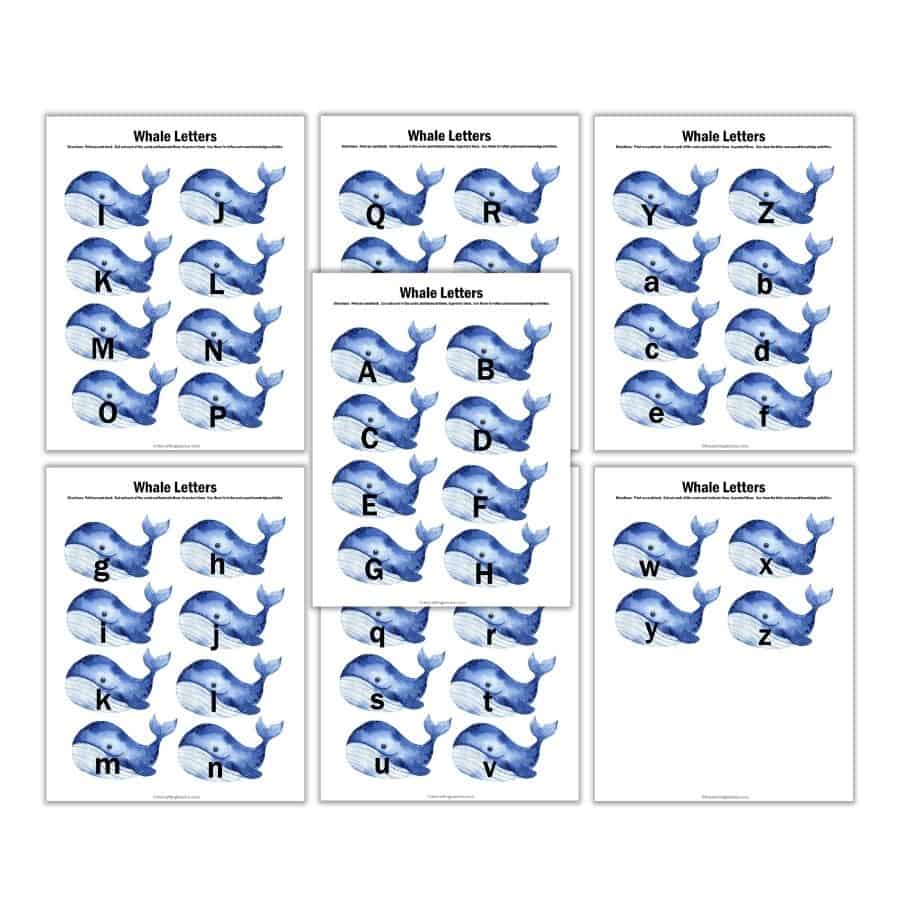
Letter Match
Provide the letter match cards, and have your children match the upper-case and lower-case letters. Invite them to say the name and sound of the letter they are matching. This letter match activity is part of the FREE Following Papa’s SONG literacy pack. It includes all the letters of the alphabet.
You just have to print using white cardstock. Cut them out on the dotted line and laminate them. Place them on a small basket, Ziploc bag, or pencil case.
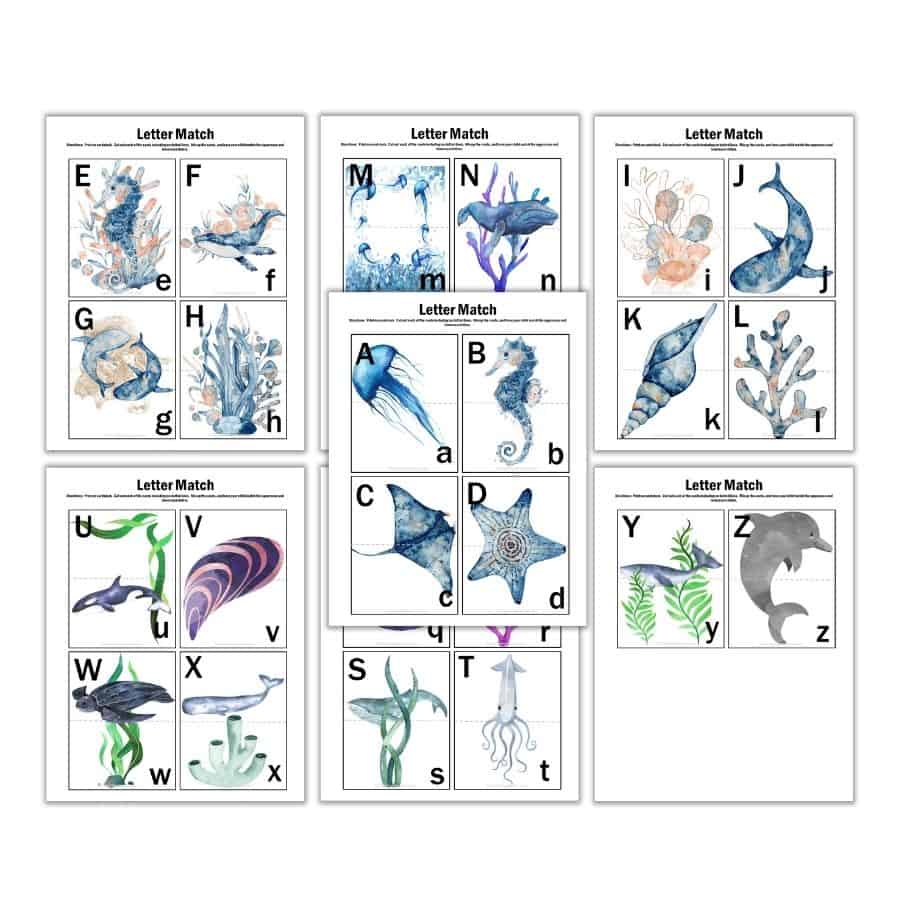
ABC Maze
Have the children review the alphabet in order by using a dot-to-dot marker to mark each letter of the alphabet in the correct order, from Little Blue to Papa. Encourage them to say the names of the letters as they go. This ABC maze activity is part of the FREE Following Papa’s SONG literacy pack.
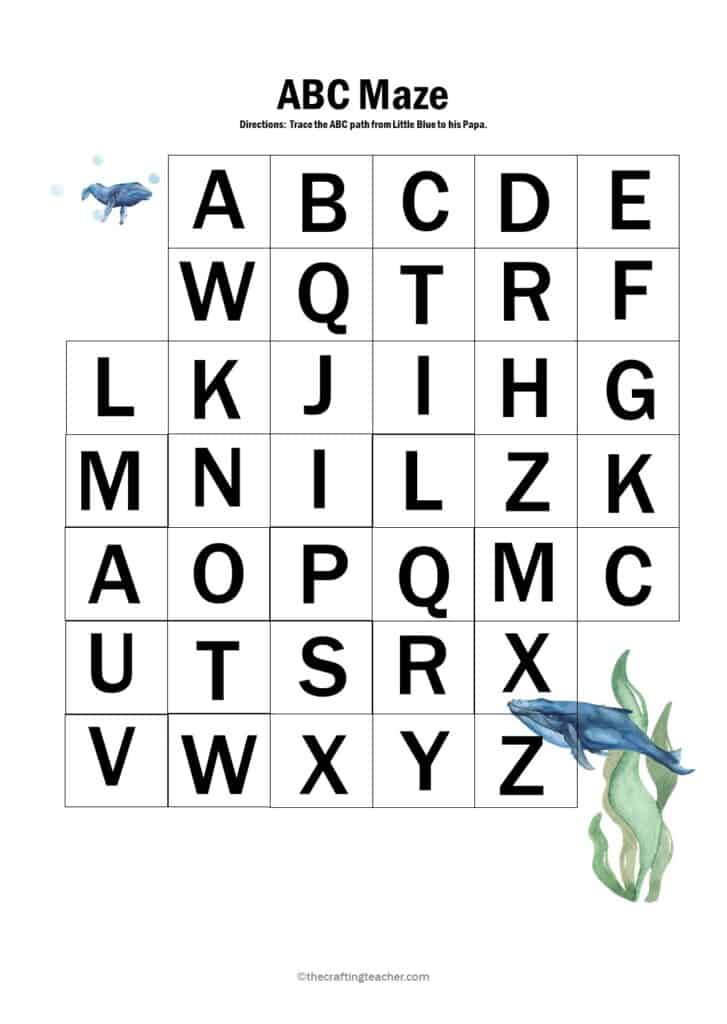
Phonological Awareness and Phonics
Letter swim
Remind your students that words are made up of individual letters. Say and spell some words from the story, using your Word Wall Cards. Ask the children to move their hands in a swim motion like Little Blue, every time you say a letter.
Little Blue Blends
Remind your children that Little Blue is a baby whale and imagine that they are going to help the little whale how to read, by blending the sounds to make words. Call out the following words, one phoneme at a time, and ask the students to practice blending the sounds to form the words.
These are some examples of the words you can use: whale – /w /h/ /a/ /l/ /e/; blue – /b/ /l/ /u/ /e/; papa – /p/ /a/ /p/ /a/; little – /l/ /i/ /t/ /t/ /l/ /e/; song – /s/ /o/ /n/ /g/.
Rhyming Words Songs
Gather the preschoolers together and practice making whale songs. Call out the word pairs listed below. Ask the students to “sing” like a whale every time they hear a par of rhyming words, or stay quiet if the words don’t rhyme.
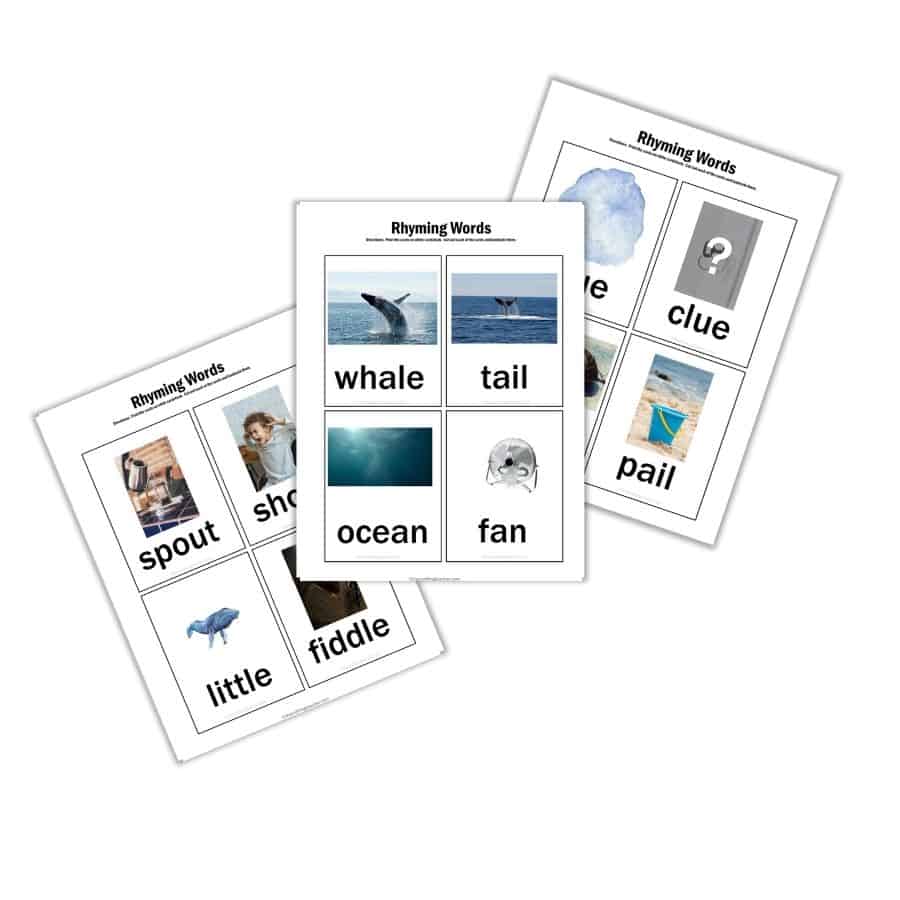
These are some of the words you can use: whale – tail; ocean – fan; spout – shout; little – fiddle; blue – clue; shell – pail. I have added all these words to your FREE Following Papa’s SONG literacy pack.
Emergent Writing
Finding Papa
After reading the story, encourage the children to help Little Blue find his Papa by tracing the path using a crayon, marker, or pencil, and the sheet provided in the printable.
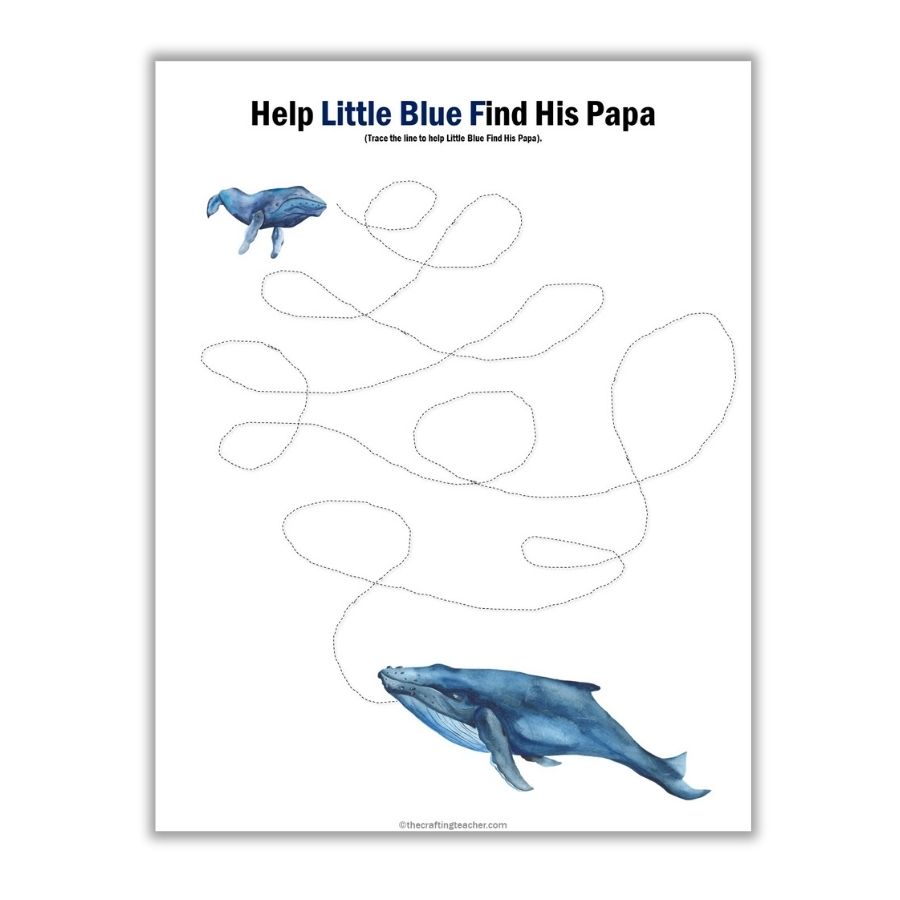
You can find this free resource as part of the FREE Following Papa’s SONG literacy pack.
Tracing Letters and Words
Print each page using white cardstock and laminate them or place them in dry-erase pockets to make them last longer, and use them multiple times. Invite the children to use a dry-erase marker to trace the letters and words.
This activity is great for strengthening the children’s language, letter recognition, pre-writing, and fine motor skills. To extend the activity you can use the to:
- Teach or review letter sounds and names.
- Spell the words.
- Match each letter and word with magnetic letters.
- Copy the letters and words with playdough.
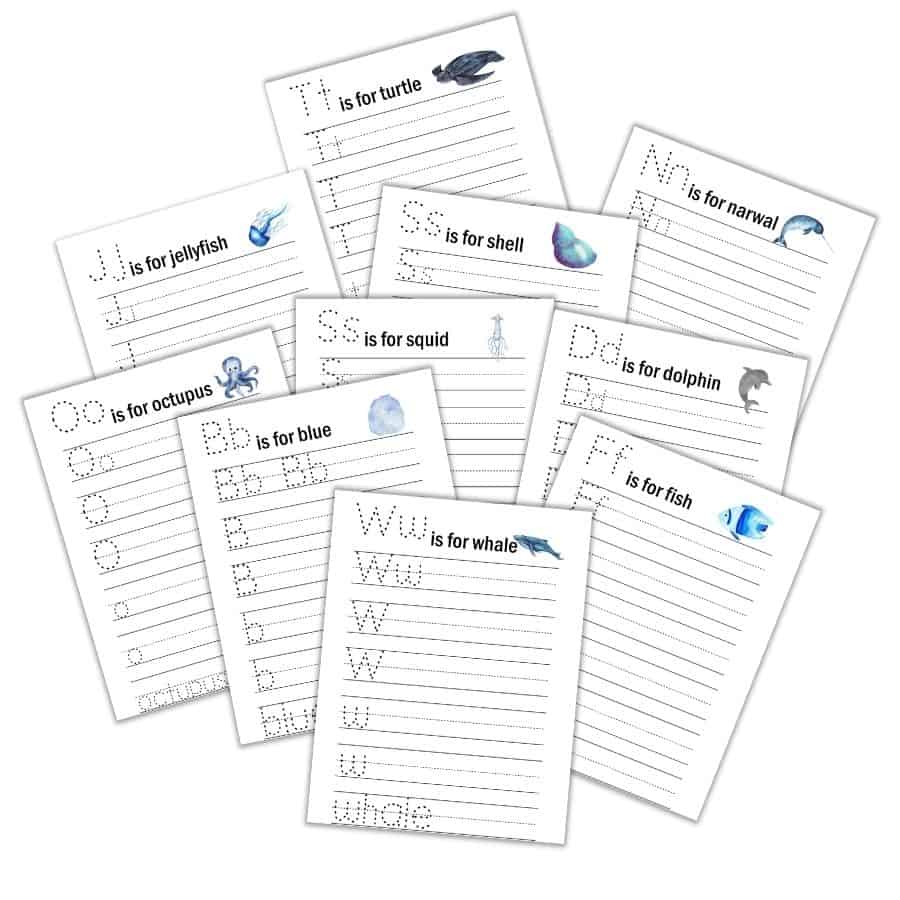
The FREE Following Papa’s SONG literacy pack includes ten sheets with the letters Ww for whale, Bb for blue, Oo for octopus, Ss for squid and shell, Ff for fish, Dd for dolphin, Jj is for jellyfish, Tt for turtle, and Nn for Narwhal.
Write a Class Story to Make a Book
During circle time invite your children to create a story, reminding them that the story has to have a beginning, middle, and end. Use a chart paper to take dictation.
You can encourage them by starting with something like “If I were a humpback whale….”.
When the story is finished, print it out and have the students illustrate the story. Put it together as a book for the library, and make a copy for each of the authors.
My Mini Book About Whales
This FREE Following Papa’s SONG literacy pack includes a super cute mini-book, that will help preschoolers learn about whales, practice, and improve their reading comprehension, vocabulary, and writing skills. It will also help them work on their letter and word recognition.
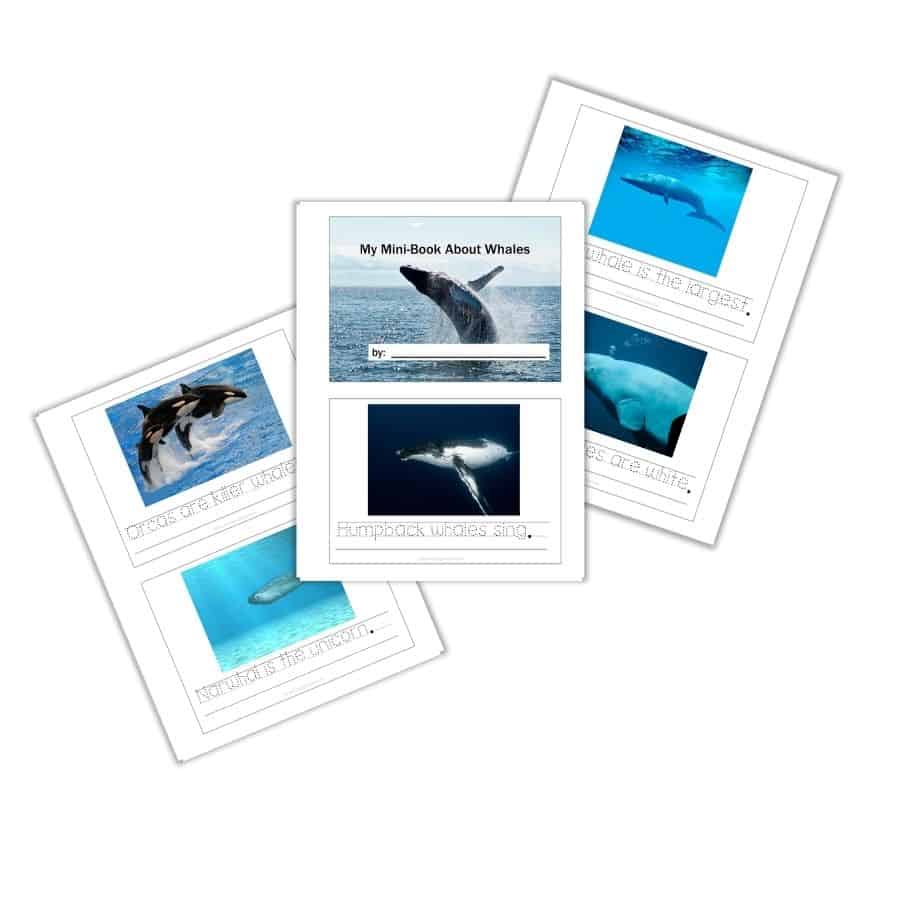
I only included five types of whales: humpback whale, blue whale, beluga whale, orca, and narwhal, to make it simple for the kids. You can help them read the simple phrases and have them trace the words afterward.
When they finish, have them cut out the pages to divide them, put them in order, write their names on the cover, and staple them together, to form the mini-book.
Songs, Fingerplays, and Rhymes
I found many songs, fingerplays, and rhymes about whales on the Bethlehem Public Library website that I found nice, and wanted to share some with you.
Blue Whales Poem
by Daniel Roure
When the sun falls to the sea
To shine on the mermaids
When the kids run out to see
The birds fly in the shade
When the whales turn into blue
And weep as we all do
Is there in the world
Anything true
When we all forget the name
Of those stars in the sky
When all battles to gain fame
Are nothing but a lie
When the whales become so few
And weep as we all do
Is there in the world
Anything true
But as long as we’re alive
There’s still a tiny chance
Just give love a little sign
To come into the dance
Give the whales a ” rendezvous”
It’s all up to you
Apart from our dreams
There’s nothing true
When all four seasons are springs
With flowers in the air
When clouds carry on their wings
Good news from here and there
When the whales along the shore
Will tell us “how are you”…
Five Baby Whales Fingerplay
(Count down using your fingers)
Five baby whales dive to the ocean floor.
One swims away and then there are…
Four baby whales eat krill in the sea.
One swims away and then there are…
Three baby whales calling in the ocean blue.
One swims away and then there are…
Two baby whales breech in the sun.
One swims away and then there is…
One baby whale is lonely and alone.
She swims to find her friends and they all go home.
Whale Action Rhyme
A whale is not as small as us, (shake head and finger)
Most whales are bigger than a bus! (stretch arms out wide)
A whale is not a fish in the sea, (shake head and finger)
A whale breathes air like you and me. (take a deep breath)
A whale can’t walk on the ground, (shake head and finger)
A whale must swim to get around. (make a swimming motion)
A whale is a mammal like you and me, (nod head, point to self and kids)
But their home is in the deep blue sea. (make wave motion)
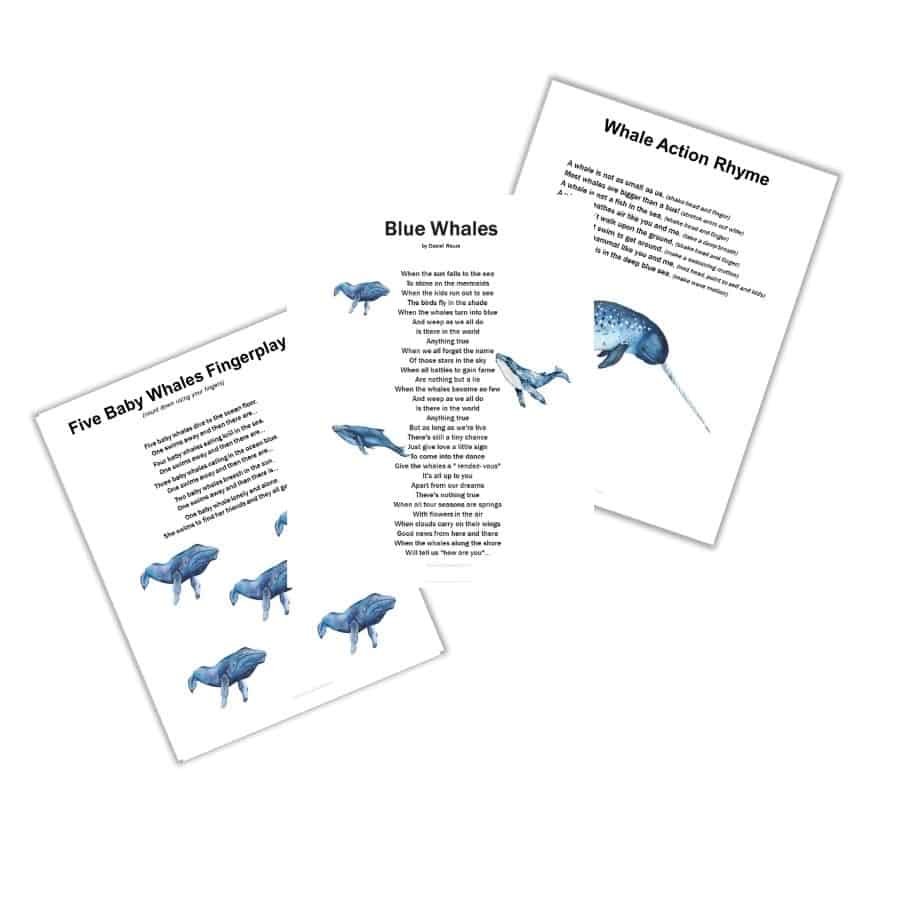
You can find this free resource as part of the FREE Following Papa’s SONG literacy pack. I found this cute little song on YouTube as well.
Other Whale-Related Books
You can always read and add more whale-related books to your library in other centers, to give children wide learning experiences and variety to choose from. I’m sure the previous activities will spark curiosity about whales, and these books could be an excellent source of knowledge. Below are some of my favorite books about whales. You can find these books at your local library, used book store, and on Amazon. The titles have my affiliate links, that will take you directly to the right Amazon page.
Secrets of the Whales by Brian Skerry. In this provocative book of photography, we learn that whales share an amazing ability to learn and adapt to opportunities, from specialized feeding strategies to parenting techniques.
Whales: An Illustrated Celebration by Kelsey Oseid. A gorgeously illustrated, entertaining, and educational guide explores the most interesting and illuminating facts about these marine mammals. It also covers the current state of wild and captive cetaceans worldwide, why we should care, and what we can do to help our beautiful marine mammal friends.
Encyclopedia of Whales, Dolphins and Porpoises by Erich Hoyt. This book is a fascinating compilation of the latest data on cetaceans and an impassioned argument for the ongoing need for international protection of at-risk populations and their increasingly damaged habitat.
The Big Book of the Blue by Yuval Zommer. The book opens by explaining how different types of animals can breathe and survive underwater, and the different families to which they belong.
The Snail and the Whale by Julia Donaldson. This is the story of a tiny snail that meets a humpback whale and travels together to far-off lands. A very sweet story about an impossible friendship.
National Geographic Readers: Whales by Jennifer Szymanski. This book includes simple text and large photos on every page. A vocabulary tree at the beginning of the book introduces kids to keywords in concept groups, helping kids make connections between words.
Song for a Whale by Lynne Kelly. This is the story is about Iris, a deaf twelve-year-old tech genius. When she learns about Blue 55, a real whale who is unable to speak to other whales, Iris thinks about inventing a way to “sing” to him! Full of heart and poignancy, this affecting story shows how a little determination can make big waves.
Whales: Amazing Pictures & Fun Facts on Animals in Nature by Kay de Silva. The book uses captivating illustrations, and carefully chosen words to teach children about the ‘gentle giants of the deep, giving a well-rounded understanding of these beautiful creatures: their anatomy, feeding habits, and behavior.
National Geographic Readers: Great Migrations Whales by Laura Marsh. This book explains how sperm whales will easily travel the circumference of the Earth in search of food and the need to breed and find a mate.
A Whale of a Tale!: All About Porpoises, Dolphins, and Whales by Bonnie Worth. While learning how cetaceans stay warm without hair, have teeth or baleen, swim in troops, spy hop, spin, breach, and see via echolocation, kids are introduced to almost 20 different species.
Pin It For Later
If you are in a rush and don’t have time to read the post and download the printable but want to save it for later, pin it to one of your Pinterest boards for later.
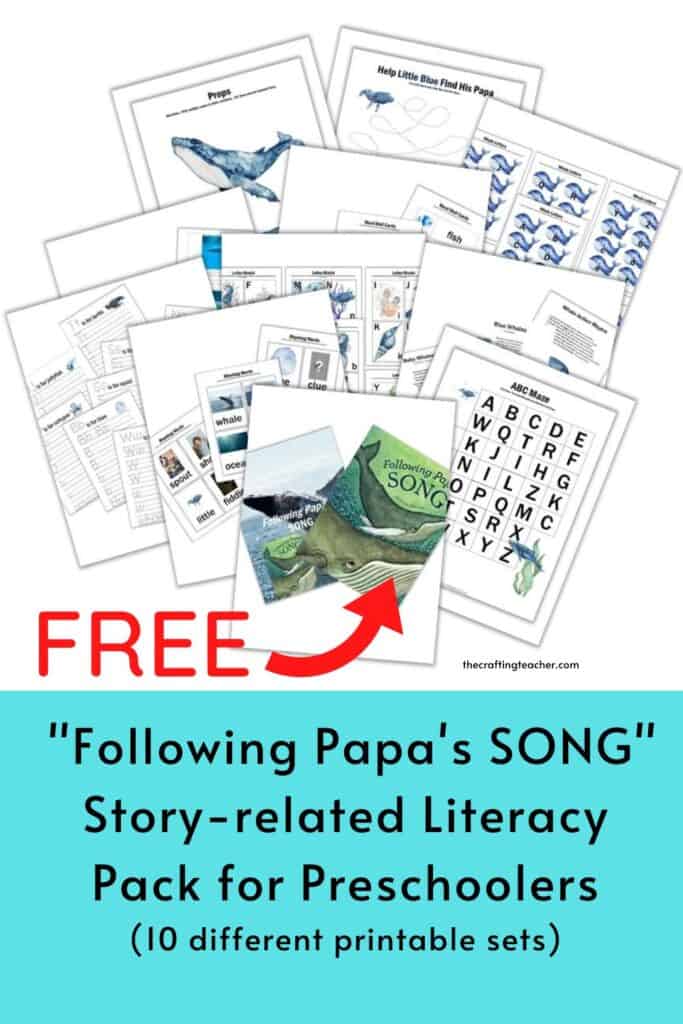
Don’t forget to download your FREE Following Papa’s Song Literacy Pack. Just click on the bottom below and type your information, for an immediate download.
You can use these ideas by themselves, but I will invite you to combine them with the science and math activities I created for this beautiful story, Following Papa’s SONG, to take advantage of the opportunity this book offers. Remember that for a more comprehensive and complete educational process, you should not divorce literacy from math, science, or any other domain. They intermingle together and complement each other.
I hope you and your children enjoy this lovely story as much as I do, and find these literacy ideas helpful.
Be happy, safe, and creative. I wish you well.
Love,
P.D. Please let me know if you think any of these ideas worked for you, or think I need to add or replace something. My goal is to help you in any way I can and I don’t like anything better than to post something that you might find useful. Also, if you come up with different ideas and want to share them, I would love to post them as well.

